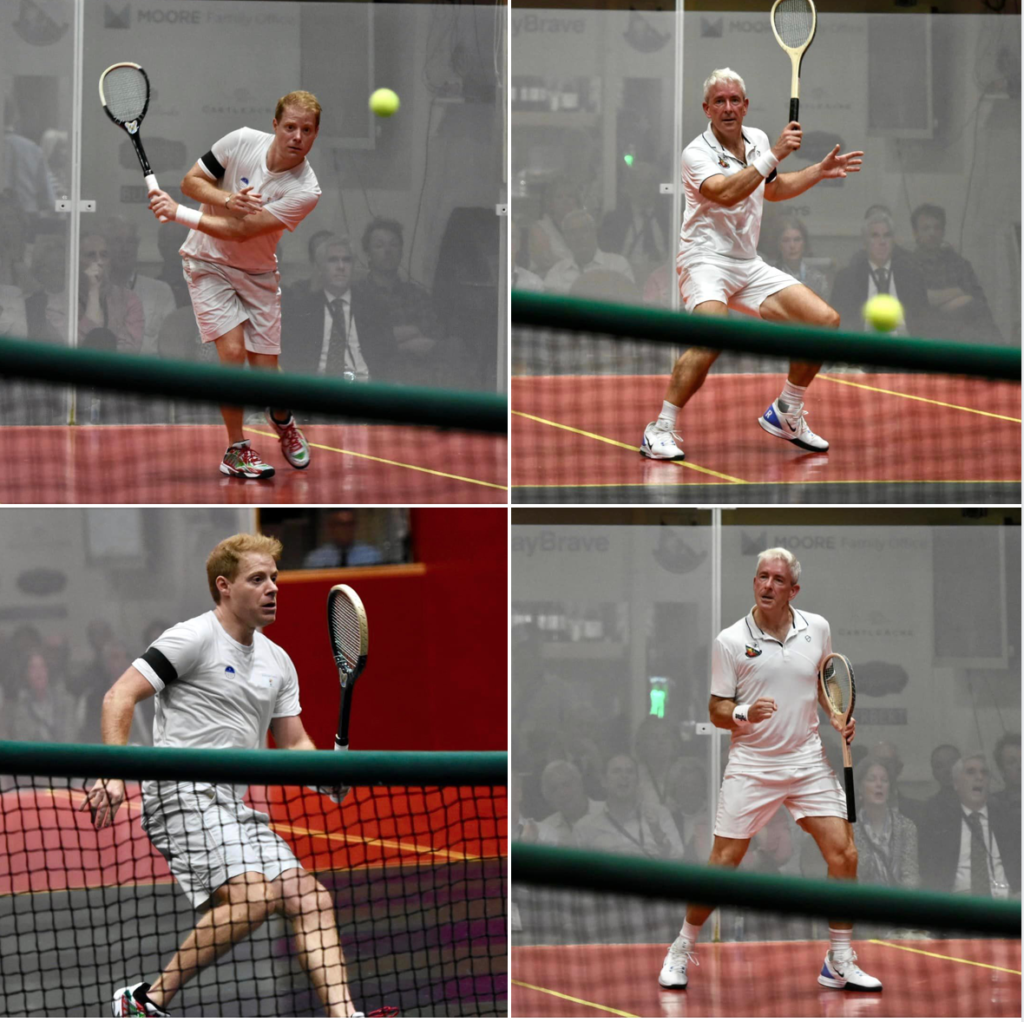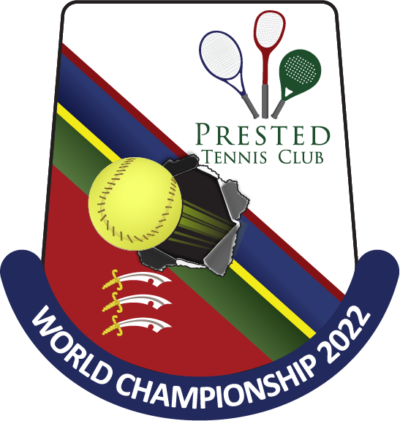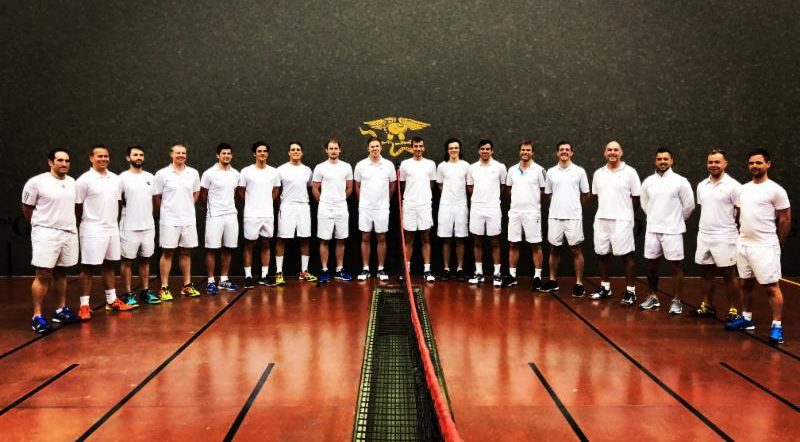by James Zug
First day
6-5, 1-6, 6-4, 2-6
It was an extraordinary first day to the 2022 World Championship.
Or rather the twice-postponed 2020 World Championship. We waited exactly 1,597 days from the astonishing third and final day of the 2018 Challenge Round at Queen’s until we all met again on the sunny grounds of Prested Hall for the next Challenge. Over four years and four months—that was a nineteenth-century sort of break between matches.
It was a lovely day in Essex with patches of bright sunshine breaking through the clouds, in the mid-seventies, fairly humid. Pol Roger supplied champagne as we reunioned together again on the lawn outside the main house. There were a fleet of people from all four-playing nations, as well as many from other countries (one even from Saudi Arabia). Among the many Americans were Aiken’s usual contingent, including Cissie & Michael Sullivan and Geoff & Shannon Ellis; Anders Cohen; Freddy Adam; Howard & Clare McMorris (Howard making his eleventh Challenge); the Vern Cassins; and most of all Ryan Carey who was brilliantly managing the live streaming from his alcove in the Prested pro shop.
A sold-out crowd entered into the galleries at Prested: sorted by lanyards (with Fahey and Riviere’s signatures on one side) we sat in in the dedans, side gallery, the glass gallery behind the hazard battery wall, the clerestory and in the royal dedans, aka the bistro. After remarks by Alistair Curley, the master of ceremonies, and Savannah Poolman, the chair of the organizing committee and a moment of silence for the recently-passed Queen Elizabeth II, the most unusual launch of a Challenge was heard: a fourteen-year-old Sebastian Adams-Eaton, in the spirit of Jimi Hendrix, precociously played the national anthems of Great Britain, the U.S. and then Australia on his electric guitar while standing at the main wall.
We were ready to rock.
Camden Riviere, the challenger, and Rob Fahey, the defending champion, wore black armbands on their non-playing arm, in honor of Queen Elizabeth. Riviere sported a tee-shirt with a large logo of the new tennis court in America, Westwood Country Club outside of Washington; black socks; and colorful sneakers. Fahey sported a collared shirt and Nike sneakers with a bright blue section that read “Air.”
Fahey won the toss (after a debate about whether an American $1 coin was fair currency to use for the flip) and elected to serve. Riviere took the first point off a chase and we were off. The first set took nearly an hour. Both players took a while to settle in and get comfortable. Riviere went up 3-1 and 4-2; at one point he was able to beat chase two. Fahey reeled off three games and then Riviere pulled one back and it was 5-5. The game at 4-4 was the highlight of the set. Fahey went up 40-15 and went through five game balls before being able to secure it. He won the thirteenth game and the first set, much to the amazement of those punters who were predicting a quick and easy route to victory for Riviere.
The second set went perhaps more according to expectations. Riviere went up 3-0 (after a marathon game at 2-0), then 5-1 and closed it out at 6-2. As usual, Riviere retrieved so many impossible balls. He also defended the dedans well and was hitting targets. In the first set he had four grilles and two dedan forces; Fahey had just one grille and four dedans forces; in the second set Riviere got five grilles but no dedans while Fahey collected four dedans and towards the end of the set he abandoned any floor game and blasted (often effectively) to the dedans.
Riviere went up 2-0 in the third set, having captured eight of the last ten games and seemingly on cruise control. Then some incandescent play from the champion. Fahey climbed back to 2-2; then 3-3; then he went up 5-3 and hung on to win the third 6-4 amid thunderous cheering from a home-town Prested contingent in the clerestory (Fahey used to run the club).
It was a master class. Fahey climbed the wall by the tambour, in his signature move from days of old, to intercept a grille-seeking ball. Three times in the match he hit a ball behind his body, showing absolutely amazing touch (if perhaps slightly faulty footwork?). Riviere found more targets in the third set—two winning galleries, four grilles and one dedans v. Fahey’s one grille and five dedans—but the match turned on one specific matter. Riviere’s serving didn’t threaten or pin Fahey down, and often Fahey was able to bully a cut volley return of serve into the main-wall corner for a winner or a chase. Riviere served mostly high drops, bobbles and the demi-pique but much of the time they were too short or too long and rarely put Fahey on the defensive.
The fourth set went fast. Riviere continued to move Fahey from side to side and up and back. He almost always turned on Fahey’s serve, taking the ball off the back wall and boasting it short to the floor near the service galleries. Fahey tired. Both players double faulted once, something very rare in a Challenge. Fahey took his time serving—wiping his hands on both sides, bouncing the ball, faulting once and going back to get a second ball. When he had time, he was able to put balls away, particularly cannoning forehands into the nick on the gallery-side of the service back wall. But there were too many unforced errors and missed targets.
Fahey was famous for winning the fourth set on the first day of the Challenge. He did it twelve times in a row, and it was only in 2016 and again in 2018 that Riviere broke that streak.. Today, Riviere captured the fourth set to garner some momentum, but it was perhaps a small consolation considering that after nearly three hours of brilliant and compelling play the two players ended where they began: tied.
Tuesday evening awaits; and we are now guaranteed a third day on Thursday.
PHOTOS BY TIM EDWARDS




